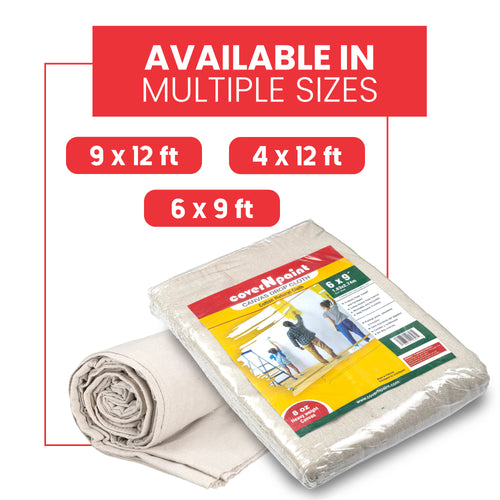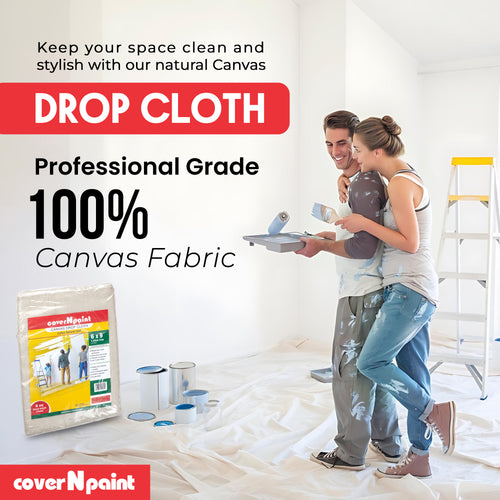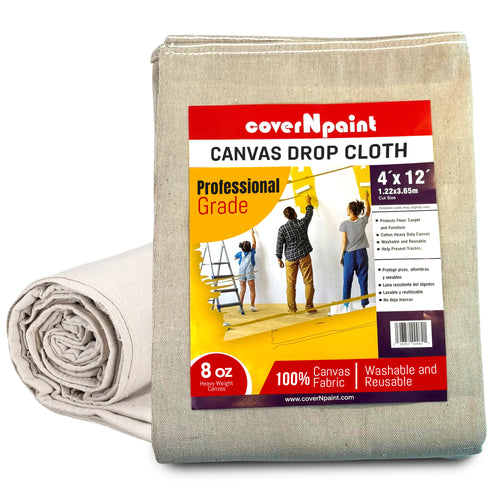Any place can appear completely different when painted, but painting can also be a dirty process. A drop cloth is a necessary tool for every painting project. By shielding your floors, furniture, and other surfaces from paint drips and splatters, the correct paint protection can help you paint faster and even save money. This post will discuss the several kinds of Drop Cloth for Painting, their advantages, and how to choose the best one for your painting project.
Types of Drop Cloths for Painting
When it comes to floor cover for painting, there are several types to consider. Each type has its own set of advantages and is suitable for different situations. The most common types are canvas, plastic, paper, and butyl-coated drop cloths.
· Canvas Drop Cloths
Canvas cloth are made from durable, woven fabric. They are highly absorbent and can be reused multiple times, making them an eco-friendly choice. Canvas painting sheet are heavy enough to stay in place, reducing the risk of them shifting and exposing surfaces underneath. They come in various sizes and weights, making it easy to find one that suits your project. Additionally, their thick material provides excellent protection against paint spills and splatters.
· Plastic Drop Cloths
Plastic drop cloths are lightweight and inexpensive. They are typically made from polyethylene and come in various thicknesses. These canvas cloths are waterproof, making them ideal for protecting surfaces from liquid paint spills. However, they are not very absorbent and can be slippery, so they may not be the best choice for areas where you need to walk frequently. Plastic tarp are generally disposable, although heavier-duty options can be reused if handled carefully.
· Paper Drop Cloths
Paper drop cloths are another cost-effective option. They are often used for smaller projects or for protecting specific areas. These canvas cloths are lightweight and easy to maneuver, but they are not as durable as canvas or plastic. Paper paint protection are typically treated to be moisture-resistant, providing a degree of protection against paint. However, they are best suited for quick, light-duty tasks rather than extensive painting projects.
· Butyl-Coated Drop Cloths
Paint spill protection with a butyl coating combine the greatest qualities of plastic and canvas. These cloths are waterproof and absorbent due to a coating of butyl rubber applied to the canvas foundation. Paint does not bleed through the butyl covering, and spills and splatters are absorbed by the canvas layer. This kind of disposable cloth is incredibly robust and reusable, which makes it a dependable and adaptable choice for a range of painting jobs.
Factors to Consider When Choosing a Drop Cloth
Selecting the best surface cover for painting involves considering several factors. These include the size of the project, the type of paint being used, and the surfaces that need protection. Understanding these elements will help you make an informed decision.
Project Size
The size of your painting project will determine the size and number of protective sheets you need. For small projects, such as painting a piece of furniture or a single wall, a smaller drop cloth may suffice. Larger projects, like painting an entire room or exterior surfaces, will require larger heavy duty cloth or multiple smaller ones to cover the area adequately.
Type of Paint
The type of paint you are using can also influence your choice of painting supplies. Oil-based paints are more likely to seep through thinner materials, making a heavy-duty canvas or butyl-coated drop cloth a better choice. Water-based paints are less likely to penetrate materials, so plastic or paper paint splatter guard may be sufficient.
Surface Protection
When selecting an interior painting protection, take into account the surfaces that need to be protected. A sturdy drop cloth that adheres to the floor is necessary to eliminate trip hazards. Lighter floor protector can offer sufficient protection without being heavy for furniture and smaller items. Additionally, a slip-resistant waterproof tarp is essential for safety if you are painting in a busy area.
A Trusted Brand for Canvas Drop Cloth
In the USA, CoverNpaint is a reputable name when it comes to canvas drop cloths. Professional painters and do-it-yourselfers alike love canvas dust sheet because of their outstanding quality and longevity. Superior, tightly woven canvas is used to make these canvas cloths, providing exceptional absorbency and resistance to paint splatters and spills. The solutions from CoverNpaint are suitable for a broad range of painting tasks, from minor touch-ups to major renovations, and come in different sizes and weights.

Benefits of Using the Right Floor Protector
Using the appropriate paint drip protection for painting offers numerous benefits. It can enhance your painting experience, protect your property, and ensure a professional-looking finish.
Protecting Surfaces
The primary benefit of a drop cloth is to protect surfaces from paint. Spills and splatters are inevitable during painting projects, and a good protective covering can save you from the hassle and expense of cleaning or replacing damaged items. By providing a barrier between the paint and your floors, furniture, and other surfaces, a multi-purpose tarp ensures that your property remains unscathed.
Ease of Use
A high-quality drop cloth is easy to lay out and move as needed. Canvas and butyl-coated painting tools, for instance, are heavy enough to stay in place, reducing the need for constant adjustments. Plastic and paper absorbent cloth, while lighter, can be secured with tape to prevent shifting. This ease of use allows you to focus on painting rather than worrying about protecting your surroundings.
Reusability and Cost-Effectiveness
Investing in a durable, reusable paint-proof cover can be cost-effective in the long run. Canvas and butyl-coated absorbent cloth can withstand multiple uses, making them a more sustainable option compared to disposable plastic or paper cloths. By choosing a reusable drop cloth, you not only save money but also reduce waste, contributing to a more environmentally friendly painting process.
Professional Results
Using the right durable cloth can help you achieve a professional finish. By protecting your work area from paint splatters, you can ensure clean lines and a neat appearance. Additionally, high-quality canvas protector provides a stable surface for ladders and other equipment, reducing the risk of accidents and allowing you to work more efficiently.
How to Use a Waterproof Tarp for Painting
Proper use of a canvas fabric protector can maximize its effectiveness and protect your space. Here are some tips on how to use a drop cloth for painting:
Preparing the Area
Before laying down your paint shield, prepare the area by moving furniture and other items out of the way. Sweep or vacuum the floor to remove any debris that could cause the drop cloth to shift. For larger items that cannot be moved, cover them with an additional paint-proof fabric to ensure full protection.
Laying the Floor Protector
When laying the paint barrier, ensure it covers the entire area you are working on. For large projects, you may need to overlap multiple floor protector to cover the surface completely. Secure the edges of the drop cloth with painter's tape to prevent it from moving during the painting process.
Using the Drop Cloth
As you paint, be mindful of spills and splatters. If you are working with multiple colors or types of paint, clean your drop cloth between uses to prevent cross-contamination. For reusable paint spill mat, allow them to dry thoroughly before folding and storing them for future use.
Making the right painting drop cloth choice is essential to a job well done. Selecting the appropriate stain resistant cover—a robust canvas drops cloth, a lightweight plastic option, or a flexible butyl-coated cloth, will safeguard your surfaces and improve the effectiveness and enjoyment of your painting process. You may choose the best absorbent cloth for your purposes by taking into account the size of your project, the type of paint, and the surfaces you need to protect. Purchasing a superior protective covering will help you easily obtain professional results while also saving time and money.













